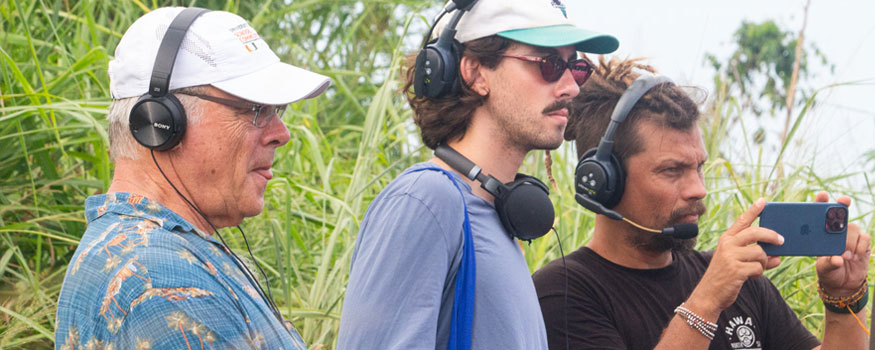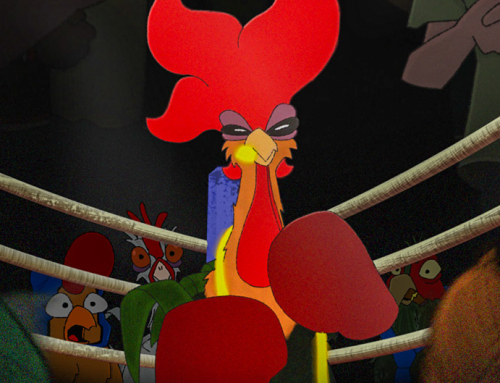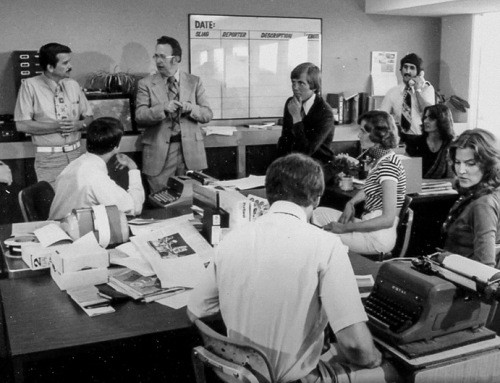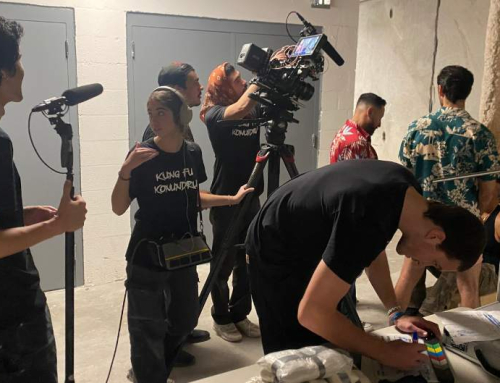Professor Tom Musca and a crew of School of Communication students and alumni spent the summer producing a feature-length film inspired by the stories of Dominican immigrants who flee to Aguadilla, Puerto Rico, seeking better opportunities.
As Tom Musca sat on the balcony of a longtime friend’s home, with the town of Aguadilla, Puerto Rico in the distance, he suddenly noticed a rustling in the trees beneath them.
When he inquired about the commotion to his friend Noel Quiñones, a pilot and film colleague, the gentleman coolly chalked up the disturbance to “just some Dominicans.”
“He was explaining to me that they come to the island in yolas (boats) and run through his property to freedom,” said Musca, professor of professional practice in the University of Miami School of Communication. “That was the first time I had ever seen a full movie in just one whole sentence.”
This past summer, the concept for “Aguadilla,” produced by both Musca and former University graduate student and producer Tim Sparks, and co-directed by his son, alumnus Alex Musca, this feature film quickly became a reality. The story examines the Puerto Rican town bearing the same name, where many Dominican Republic immigrants find new socioeconomic opportunities and political freedoms.
With the casting of Lou Diamond Phillips, renowned for his notable role in the Oscar-nominated film “Stand and Deliver” (1988), produced and written by Musca, and along with the enlistment of other talented and current University students as crew members, another feature film was poised for production.
Then came the Writers Guild of America (WGA) and Screen Actors Guild-American Federation of Television and Radio Artists (SAG-AFTRA) strikes. They called for thousands of writers and actors across the country to halt all work in an effort to demand better wages and address concerns about streaming services and the normalization of work produced through the use of AI.
“I’ve been a WGA member for 40 years, so I had a feeling that [the writers’ strike] was imminent,” said Musca. “I was hoping it wouldn’t come, but it did. Fortunately, we could keep working because I locked the script prior to the strike, but then we had to stop after four days of shooting because of the SAG strike.”
In partnership with independent production company Abla Films LLC, according to Musca, the project was able to continue by signing an interim agreement that agreed in advance to the terms and conditions presented by the the unions. This was a win that most writers and actors have yet to experience since the beginning of the strikes.
“We got lucky, and you’ve got to be lucky to make a film,” Musca said. “Especially at a lower budget and especially with a narrative scope as ambitious as this one.”
Though it isn’t typical for feature-length films to be put together in the span of a summer, let alone for someone to do it four times as this prolific screenwriter, director and producer has in his career, “Aguadilla” proved to be a shining antithesis to what it takes to make a Hollywood-style film today.
Ryan Berman, a fifth-year student in the School of Architecture, recalled having worked intensely to create the atmosphere for scenes as the project’s art director, despite “Aguadilla” being his first-ever feature film.
After deciding to dabble in the University’s film curriculum, Berman took Musca’s screenwriting class. The student created a digital model of a sci-fi world that impressed his professor—so much so, he got a call to go to Puerto Rico.
“There were a few big projects I was tasked with while on the set,” Berman explained. “I transformed a shed into a shrine filled with the immigrants’ objects that washed ashore, built a replica of the shrine so it can be set on fire, and created a functional raft out of a bunch of things I found at different shops that we dirtied up to make it look like it had been through the ringer.”
Aside from behind-the-scenes collaborations, “Aguadilla” delves into a multifaceted narrative of a profound love story. It also focuses on socioeconomic disparities and the physical and emotional vulnerabilities of its characters—including the wheelchair-bound main character, inspired by Musca’s friend, Quiñones.
The intention behind this tropical film-noir is to depart from conventional migrant narratives, a motivation of Musca’s fueled by his collaboration with Sparks. The duo constantly has aimed to spotlight Latino stories and their complexities.
“This movie is really different in terms of its commercial value compared to other films I’ve done. It’s got a lot more romance, action and violence on screen,” Musca said. “But these characters are very human people with their own lives, their own dreams, their own greed, their own desires, goals, needs. And I really wanted to depict three-dimensional complex migrants, which I don’t see a lot of in the news or mainstream entertainment.”
Rodrigo Arauz, a recent graduate of the University, worked as assembly editor for the film. He noted that his bilingual background and classes at the School of Communication helped him feel prepared for the role when Musca first proposed the job to him.
“I feel really grateful that this is a UM project and that I am part of the UM School of Communication family,” Arauz said. “This is a great opportunity for me because I haven’t worked so hands-on on a project of this scale. I had always worked on short films. It feels like my dream job, editing feature-length narrative films. And I’m just glad that the University of Miami and the professors have helped me get to this point. I’m extremely fortunate.”
With the film in its post-production stages, Arauz is tasked with molding each piece together to tell the story it’s meant to tell. For a student who always knew he wanted to be a storyteller, he feels up to the challenge of helping to fulfill the vision of his mentors.
“Since I was little, I’ve been drawn to storytelling,” said Arauz. “Initially, I wanted to be a writer and an English major, but I struggled with writing prose. I gravitated toward screenwriting because it allowed me to convey stories visually, and I always grew up loving animation and visual stories,” he added. “Editing kind of became this natural fit as I enjoyed piecing together narratives, and I’ve been making videos since I was a kid. Then in my classes at UM, I had a professor who recognized my editing talent and encouraged me to pursue it further, which only fueled my passion for storytelling.’’
As proven by students like Arauz and Berman, “Aguadilla” is more than just a film; it’s a symbol of the boundless possibilities that arise when talented students and faculty members come together under the banner of creativity and with the desire to amplify voices of communities that need to be heard.
“It was amazing to me how the University of Miami has allowed me to customize that curriculum to help me match my passions for architecture and film, two areas that would otherwise be totally opposite,” said Berman. “There really is nothing like being on a film set, and I owe it to the connections I made at UM to give me this opportunity. It was just a dream come true.”






